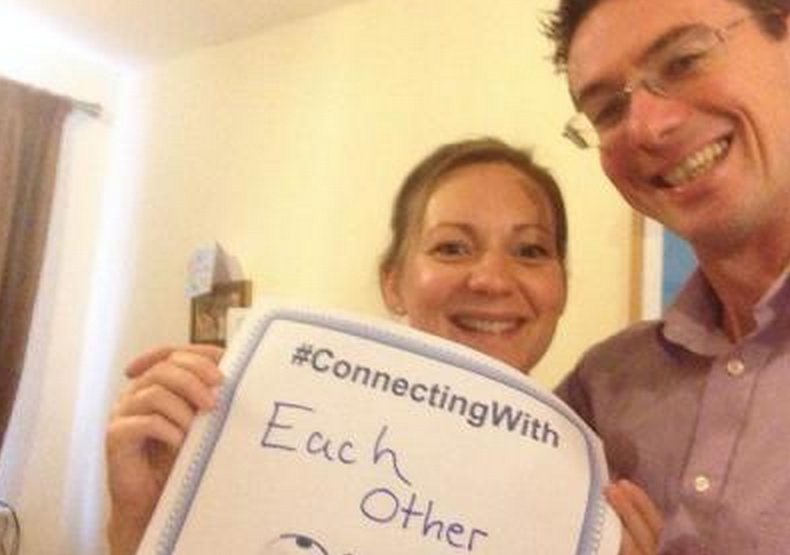
Back in January I wrote a Mental Elf blog on suicide prevention in young people and since then Elves have reported on aspects of suicide cause, effect and prevention in a number of blogs.
Recently, suicide has hit the mass media/social media headlines a number of times prompted by events like Robin Williams’ apparent suicide and by the WHO report I alluded to back in January; the one which reports that suicide kills one person worldwide every 40 seconds (WHO, 2014).
All of this media attention has no doubt increased the general public’s awareness of suicide and the consequences to those bereaved by suicide, but how many of us have considered that this reporting might actually lead to others taking their own lives?

World Suicide Prevention Day on 10th September 2014 saw the launch of the #ConnectingWith campaign, spearheaded by liaison psychiatrist Alys Cole-King @AlysColeKing
A recent study published by a group of scientists from around the UK has addressed this question in some detail by collating and analysing data from previous studies which reported on suicide clusters (Niedzwiedz et al, 2014).
To be more precise, they looked at published data on so called “point-clusters”. These involve suicides or episodes of suicidal behaviour localised in both time and geographic space, often occurring within specific communities or institutions. The authors rightly highlight that although there have been previous studies, to date there is no agreed definition of a “suicide cluster”; should this include or exclude suicidal attempts? Nor is there consensus about the minimum number of events that constitute a “cluster”.
What did they want to find out?
The study set out to broaden the understanding of suicidal cluster epidemiology by posing 5 questions:
- How are suicide clusters defined in the literature?
- Is there evidence that suicides or suicidal behaviour occurs in clusters?
- Does suicide or suicidal behaviour cluster in specific settings?
- What proportion of suicides is estimated to occur in clusters?
- What are the key characteristics of suicide clusters?
Methods
The authors searched 8 databases (Medline, Psychoinfo, Web of Knowledge, Applied Social Sciences Index & Abstracts, Educational Information resource Center, International Bibliography of Social Sciences and Sociological Abstracts & Social Services Abstracts) with no language or study design restrictions.
Inclusion criteria included:
- Publication in a “scholarly journal and related to both the temporal and spatial clustering of suicide or suicide behavior (including self-harm)” (author’s emphasis used).
- In addition they also considered any article which related to perceived clusters or statistical analysis of suicide clusters.
- They also eliminated any non-English language publications.
- Finally, they also included different articles reporting results from the same cluster, if they felt they contributed evidence over and above any previous report.
They then used a narrative synthesis approach as opposed to conducting a meta-analysis as they considered the studies to be too heterogeneous. Narrative synthesis is defined by the authors as: “an approach used in systematic reviews to combine results from several studies that relies on the use of words and text to summarise and explain the findings of the synthesis.” (See Popay et al for further information).

Narrative synthesis is a well established approach used in systematic reviews.
Results
They used 82 articles published between 1960 and 2013. Of these, 7 reported on results from the same cluster as these added weight to the information published in the original article(s).
What definitions of suicide clusters did they find?
Less than a third of the studies defined suicide cluster. Those that did included both time and location in the definition. Time varied from one or two weeks to more than a year. Location varied from “population”, “institution” to “country” in which the suicide took place. The study recommends that we adopt the following definition:
A series of three or more closely grouped deaths within 3 months that can be linked by space or social relationships.
What evidence did they find that suicide occurs in clusters?
The study identified three types of evidence for clusters in the literature:
- Studies which described the occurrence of one or more perceived cluster (mainly in case studies) N=38;
- Studies which statistically examined “time” and “location” clustering (including completed and attempted suicides and usually in cross-sectional or cohort design (N=20);
- Studies of higher methodological quality. These included both a description of a suicide cluster and provided statistical evidence (N=17).
Does suicide or suicidal behaviour cluster in specific settings?
The authors concluded:
Suicide clusters appear to occur in specific institutional settings, such as psychiatric hospitals, schools, prisons and military commands. There was also evidence to suggest that clusters occur among indigenous communities, the general population, and some work community settings.
Noteworthy was the conclusion that most clusters involved young people.
What proportion of suicides is estimated to occur in clusters?
The heterogeneity of the studies analysed meant it was difficult to distil any conclusions about how suicide clusters in time and space. However, they were able to suggest:
that approximately 1-2 % of adolescent suicides were clustered in the USA and around 2.4% of all suicides in Australia.
What are the key characteristics of suicide clusters?
The heterogeneous nature of the studies included in this review meant it was difficult to define key characteristics. This was particularly hampered by the lack of information regarding the reporting episodes of suicidal behaviour and the lack of reporting on the age of those studied. The time periods within which suicide clusters occurred varied from 24 hours to 5 years. The number of incidents involved in clusters likewise varied, but generally, a high number of incidents was found to occur within a more concentrated space of time in certain settings.
From all of the evidence that this study considered, the investigators were able to establish that clusters occur in a variety of settings and that most involved young people (N=32).

This review found that suicide clusters arise in many settings and often involve young people.
Conclusions
So, is suicide contagious?
Most likely yes it is, but does this study confirm this?; probably not.
It is possible to highlight the limitations of both this study and those that it used to reach its tentative conclusions. Not least of these limitations lie in the quality and quantity of the data available. We elves have a healthy obsession with data quality and this study lacks any of the “usual” raft of statistical analyses of data from RTCs, with clearly defined control groups and terms like “statistically significant” in the findings.
The authors accept and acknowledge these limitations and the heterogeneity of the studies that they assessed. However, this study used appropriate methodology (a narrative synthesis approach) to tentatively pull some of the existing data on suicidal clusters together and in doing so highlighted trends in suicide clusters and the need for more research:
Future studies should aim to combine the statistical analysis of time-space clustering with a case study of events, which examines potential links between individuals and the wider environmental context.
If you need help
If you need help and support now and you live in the UK or the Republic of Ireland, please call the Samaritans on 116 123.
If you live elsewhere, we recommend finding a local Crisis Centre on the IASP website.
We also highly recommend that you visit the Connecting with People: Staying Safe resource.
Links
Niedzwiedz, C., Haw, C., Hawton, K. and Platt, S. (2014), The Definition and Epidemiology of Clusters of Suicidal Behavior: A Systematic Review. Suicide and Life-Threat Behavi. doi: 10.1111/sltb.12091
Preventing suicide: a global imperative. World Health Organization, 2014.

Is suicide contagious? Read about it in my latest @Mental_Elf blog. http://t.co/mTAOcPUzFY
Is suicide contagious? Definition and epidemiology of suicide clusters: Mark Smith summarises a recent narrati… http://t.co/RIa7rBzgBy
Today @121therapy on a systematic review of the definition and epidemiology of clusters of suicidal behaviour http://t.co/6Vv5hczggW
Is #suicide contagious? Definition and epidemiology of suicide clusters http://t.co/YHrkZoszhw @Mental_Elf @121Therapy
#SuicideClusters “Series of 3 or more closely grouped deaths within 3 mnths, linked by space or social relationships” http://t.co/6Vv5hczggW
New @Mental_Elf blog on our review of the epidemiology of suicide clusters http://t.co/NwbZ3YKOn3 Full paper here http://t.co/WHbAFKirn3
Is suicide contagious? Definition and epidemiology of suicide clusters http://t.co/DIkd6GfhUy via @Mental_Elf via @121Therapy
“Suicide clusters appear to occur in specific settings: psychiatric hospitals, schools, prisons & military commands” http://t.co/6Vv5hczggW
@Mental_Elf & doctors. Don’t forget high rate of suicide amongst medical profession
@clarercgp @Mental_Elf With the stream of human misery that passes your doors its to your credit that its not higher
@clarercgp in private practice or mainly just NHS workers? I don’t know NHS worker in my field would recommend to kids. I would @Mental_Elf
@clarercgp @Mental_Elf The U of A lost 2 prominent psychiatrists within 6 weeks of each other several years ago.
Systematic review finds that suicide clusters arise in many settings and often involve young people http://t.co/6Vv5hczggW
Hiya @AlysColeKing We’ve highlighted #ConnectingWith in our blog on suicide clusters today: http://t.co/6Vv5hczggW #SuicidePrevention
Mental Elf: Is suicide contagious? Definition and epidemiology of suicide clusters http://t.co/rT50AenUG0
Is suicide contagious? Epidemiology of suicide clusters http://t.co/Mxsrgryani
Is suicide contagious? Definition and epidemiology of suicide clusters via @Mental_Elf http://t.co/i9BZD88GRe
Is suicide contagious? Definition and epidemiology of suicide clusters http://t.co/WUxf54bJe6 via @sharethis
Don’t miss: Is suicide contagious? Definition and epidemiology of suicide clusters http://t.co/6Vv5hczggW #EBP
@Mental_Elf An interesting read again highlighting the need for a public health approach to suicide prevention & early intervention for CYP
Don’t miss my latest @Mental_Elf blog: Is suicide contagious? Definition and epidemiology of suicide clusters http://t.co/mTAOcPUzFY
Is suicide contagious? http://t.co/tNQw3X5n20 via @sharethis @Mental_Elf @121Therapy #mentalhealth #health #healthcare
Definition and epidemiology of suicide clusters | http://t.co/tlHb4vaFSJ
Most popular blog this week? @121Therapy Is suicide contagious? Definition & epidemiology of suicide clusters http://t.co/6Vv5hczggW